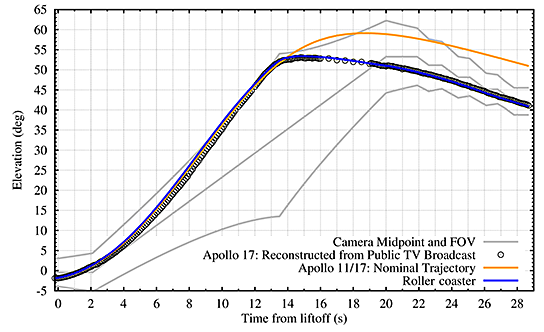The Apollo 17 Anomalous Ascent Trajectory
When humans visited the Moon for the last time in December of 1972 as a part of the Apollo 17 mission, the ascent of the Lunar Module (LM) from the lunar surface was captured by a remotely-operated camera that was left on the Lunar Roving Vehicle (LRV) or lunar rover, and broadcast live across television networks worldwide.
From the broadcast recording we first reconstruct the elevation of the ascending LM Ascent Stage (AS) from the vantage point of the TV camera. As a part of that reconstruction we ascertain how NASA camera operator Ed Fendell operated the camera to be able to track the LM AS.

Reconstruction of the vessel trajectory from the NASA TV broadcast
We consider two types of vessels to reproduce the scene and find that:
- For the rocket with the same propulsion as Apollo, its Reactive Control System (RCS) has to be much quicker than that of Apollo, and the resulting Orbit Insertion trajectory cannot be performed with Apollo's guidance logic.
- A roller coaster, comprising a jet-propelled cart sliding along tracks, pitched so that they mimic the ascent trajectory, can be constructed that reproduces the broadcast perfectly.
The roller coaster also explains certain details of the trajectory that are inconsistent with the rocket propulsion (vessel acceleration increases with pitch, distance between the vessel and the camera later in the broadcast).
In conclusion, we find that the television broadcast most likely comprised a staged, scaled-down ascent, and not an actual LM ascent from the lunar surface.

The Apollo LM cannot fly along the trajectory as seen in the TV broadcast, but the roller coaster can
Julius A. Birch PhD
Aulis Online, August 2016
![]() Read the full analysis by Julius A. Birch PhD here
Read the full analysis by Julius A. Birch PhD here
Email: Julius Birch
About the Author
Julius Birch received his PhD in applied (engineering) physics from the Fakultät für Mathematik und Physik of the Hannover University, Germany. After a brief post-doctoral work at his alma mater, he moved to the USA to pursue a career in applied industrial research. Currently Julius Birch is with a private company working on problems in system analysis & control, and remote sensing. His interest in NASA's accomplishments started after he viewed a YouTube documentary about the Moon.
This article is licensed under
a Creative Commons License
AULIS Online – Different Thinking
